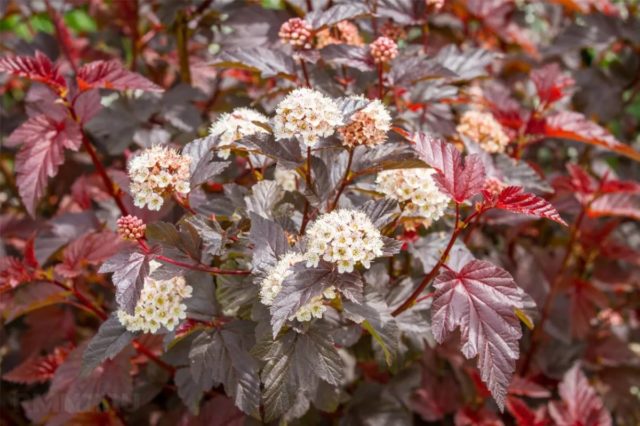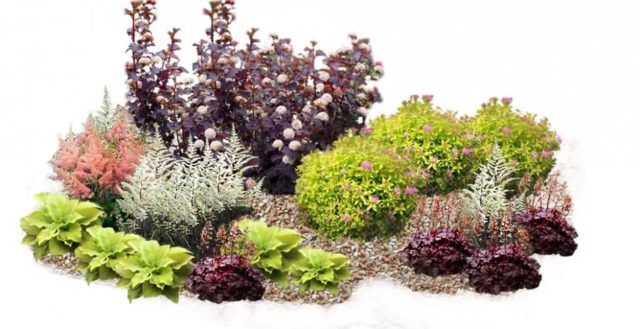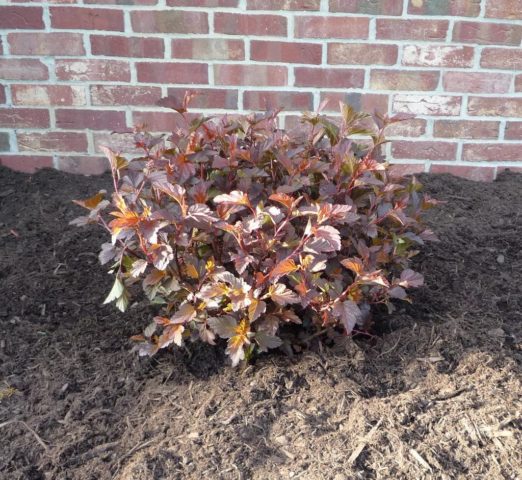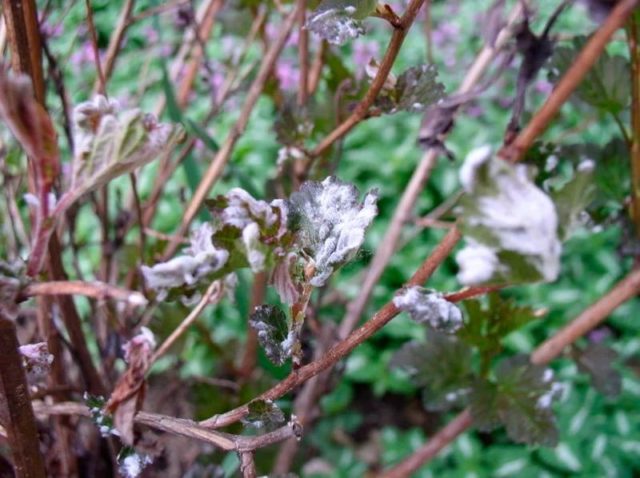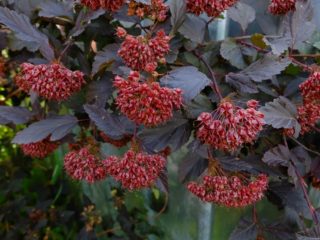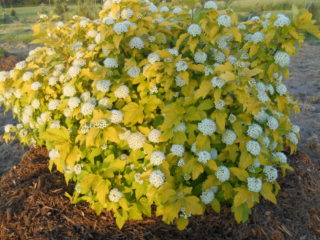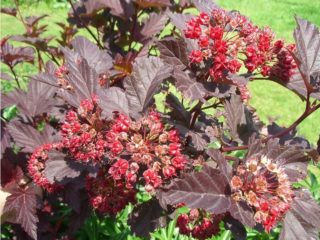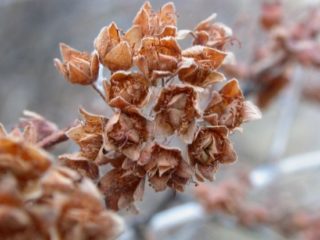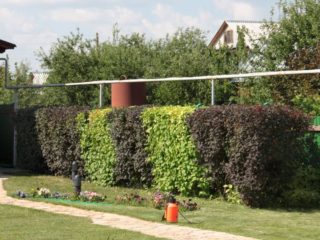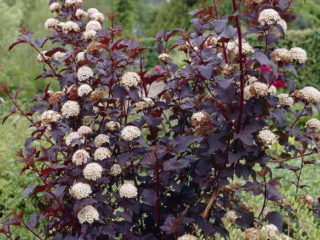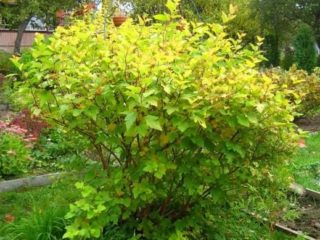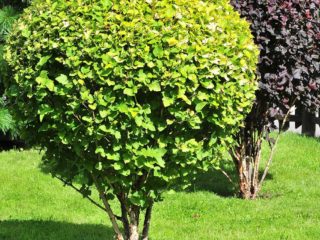Content
The Vine-leaved bubblegum appeared relatively recently - at the end of the 18th century. Since then, this unpretentious plant is often used in landscape design and ornamental gardening. Planting and caring for the viburnum bladder is simple, so even novice gardening enthusiasts can easily cope with the cultivation of this shrub.
Features of planting and caring for the bladder shrub
The homeland of the viburnum-leaved vesicle is North America. Under natural conditions, this plant is quite common in the northeastern United States and Canada. Distribution area - mixed forests, river banks. Initially, the viburnum bladder was brought as an exhibit to the Imperial Botanical Garden of St. Petersburg, and closer to the middle of the 19th century it spread widely in other regions of European Russia.
This article provides a description of the viburnum bladder, gives the basic principles of planting and caring for it, presents a photo of the plant in various options for its use.
Vine-leaved bubble is a deciduous shrub with a height of 1 to 3 m.It is very decorative at any time of the year due to reddish-brown shoots forming a sprawling spherical crown, as well as dark leaves with a red, purple or burgundy hue. Some varieties have yellow or lemon-colored leaves. The shrub is unpretentious in cultivation, has excellent frost resistance, tolerates gas pollution, and is therefore widely used for landscaping streets and industrial areas.
How to plant a bladder
In decorative gardening and landscape design, the viburnum bladder can be used both to create individual compositions in the form of color accents or geometric shapes, and for hedges. When landing, the following factors should be considered:
- The plant does not tolerate calcareous soil well.
- Water stagnation in the roots should not be allowed.
The shrub is undemanding to illumination, however, in the shade of the foliage it becomes lighter and slightly loses its decorative effect, acquiring the usual green color.
Landing dates
The best time for planting the viburnum bladder is spring and autumn. Seedlings with a closed root system (from a container) can also be planted in summer. The rooting rate of this plant is very high.
Bubble soil
The viburnum bicarp is undemanding to the composition of the soil, the main thing is that it is not alkaline. This shrub grows well both on loam and sandy loam lands, but it will have the most decorative appearance if planted on loose fertile soil. The plant is sensitive to excess water, so you should avoid places where moisture can stagnate, and when planting, be sure to equip drainage.
The distance between the vesicles when planting
When creating hedges, the seedlings of this ornamental shrub are planted in a checkerboard pattern in 2 rows, observing the distance between adjacent seedlings 45-50 cm, and between rows 35-40 cm.This allows you to obtain sufficient density so that the trimmed hedge does not seem transparent.
Planting patterns with a vesicle
The hedge of the viburnum leaflet is usually limited to pruning from 1, 2 or 3 sides, giving the shape of a rectangle. In addition, the plant can be planted as a tapeworm, as well as in composition with other garden and park plantings. Often, the viburnum bladder is used as part of mixboards, highlighting it as a color accent, or used as a background, planting lighter plantings in front of it.
The bubble plant as part of the mixboard is in the photo below.
Rules for planting bladderworms:
- Planting the bladderwort is very simple. For planting, planting pits are prepared in such a way that they are larger than the volume of the root system of the seedling.
- A drainage layer must be poured at the bottom. Building expanded clay is well suited for this purpose, you can use crushed stone, brick fragments or even coarse sand.
- A mound of earth is poured at the bottom, spreading the roots of the seedling over it, after which the pit is gradually sprinkled with soil, periodically compacting it.
- After the planting hole is completely filled, the root collar of the plant should be flush with the ground.
- If the seedling is in a container, then it is removed and transplanted together with the soil, without shaking it off from the roots. So that the plant can be freely removed, 10-15 minutes before planting, the soil in the container must be watered.
- A carefully removed seedling is placed vertically in the planting pit and covered with earth.
- After planting, the plant must be well watered, and the root zone must be covered with a layer of peat or humus mulch.
What to plant next to the vesicle
A variety of plants can be neighbors of the vesicle. In landscape design, this shrub is often planted next to narrow pyramidal conifers, lighter deciduous shrubs, and large flowers. The plant is not selfish and gets along well with all neighbors. The only exception can be large trees with a large number of superficial roots, for example, willow or chestnut. Near them, the shrub will lack nutrients and be inhibited.
Kalinophyta bladders are red-leaved and yellow-leaved. The former include such varieties as Diabolo, Red Baron, the latter - Luteus, Dartsgold. Often they are planted side by side, alternating varieties of different colors. Such a motley hedge looks very picturesque and original.
How to grow a bladder
After planting in the spring, the vibrocarp requires minimal maintenance. However, in order not to start the plants, some activities are still better to carry out. Such works include:
- watering;
- top dressing;
- pruning.
In addition to these works, many gardeners take additional measures to care for the root zone. It is weeded, loosened, mulched. For decorative purposes, a border of stones of various sizes is often built around the shrub.
Watering and feeding
Watering is required only in hot dry periods. At this time, it is advisable to pour 2-4 buckets of water under the root of each adult bush 1-2 times a week. In the rest of the year, the plant is quite sufficient and atmospheric precipitation. Excess moisture will harm the bladder much more than its lack, so you should not be zealous with watering.
It is not necessary to feed the bushes, the fertility of the soil is of secondary importance for this plant.Despite this, fertilizers can and even need to be applied if the viburnum leaflet is grown on poor soils. Usually, feeding is done twice a season. In the spring, the bushes are fertilized with a solution of nitrogen-containing fertilizer, for example, nitroammofoski. This stimulates very well the growth of shoots and an increase in green mass. Organic infusions, slurry or chicken droppings are often used. Such fertilizers are applied to the trunk circle in the form of aqueous solutions. In autumn, superphosphate and potash fertilizers are used. This strengthens the plants before hibernation.
Trimming and shaping
Pruning bladder bushes is done for several purposes:
- Sanitary pruning... It is carried out in early spring and autumn, as well as in case of emergency (damage to the bush, disease, mechanical damage). Sanitary pruning removes dry, broken, improperly growing or diseased or pest-affected branches.
- Formative pruning... It is produced in order to increase the density of the crown or to give it a decorative look. To give the bush a fountain shape characteristic of the bubble, large branches are cut off at a height of 1.5 m of earth, and thin shoots are removed completely. If the goal is to get a bush of maximum density, the branches are cut at a height of half a meter, stimulating the growth of a large number of side shoots. After forcing the shoots, the crown is cut to the desired size or given a certain shape.
- Anti-aging pruning... It is carried out once every 4-5 years. Its purpose is to remove old shoots and grow young ones instead. In this case, part of the age branches are cut out at the root, and young ones are grown instead. For several years, the complete rejuvenation of the bush is carried out.
Useful video on the topic of pruning the vesicle:
Bladder transplant
If, for some reason, the viburnum bush must be transplanted to a new place, then this can be done either in early spring, before the beginning of the growing season, or in the fall, after the end of the leaf fall. The transplant must be done together with a lump of earth on the roots. The older the bush, the greater the volume of its root system, therefore, transplanting adult bushes is much more laborious. Before transplanting, all plant stems are shortened to a length of 0.2–0.3 m. This will reduce the load on the root system and facilitate its early adaptation to a new place.
For transplanting, the bush is dug in from all sides, trying not to damage the roots. Then the plant is removed from the ground and transferred to a new location. It is best to do this on a piece of thick fabric, so you cannot do without outside help.
The bush is transplanted in the same order as the planting of a young plant. Transplanted bushes are installed in the pre-dug planting holes, after which the existing voids are covered with earth. To speed up adaptation, the planted bushes are watered with a solution of a root formation stimulator (Kornevin or Heteroauxin). To reduce the evaporation of water, the ground around the transplanted bush is covered with a layer of mulch. Dry peat is well suited for this purpose.
Preparing for winter
The bicarp is characterized by excellent resistance to negative temperatures. He is not afraid of even the most severe frosts. Therefore, no measures should be taken to prepare it for the winter. The maximum that can happen to him during the winter is the tips of the shoots will freeze. This happens quite rarely, in the most severe frosts. If this happens, then in early spring, the frozen ends will need to be cut off during sanitary pruning.
The subtleties of growing a vesicle in different regions
Differences in the care and cultivation of the bladderwort in different regions of Russia are minimal. This is due to its unpretentiousness and frost resistance.
Planting and caring for the vesicle in Siberia
Planting and care in the open field for the viburnum bladder in Siberia does not differ from the generally accepted ones. Young seedlings are planted at the same time, the planting procedure is standard. Plant care is minimal. Preparation for winter is usually not done. The frost resistance of this ornamental shrub is enough to winter without shelter even in Siberia.
Agrotechnics of cultivation of a vesicle in the suburbs
In the Moscow region, the climate is much milder than in Siberia. However, much more precipitation falls here, so when planting, you need to choose a place where water does not stagnate after rains. It is imperative to drain the planting holes. In other respects, the procedures for planting and caring for the bladderwort in the Moscow region do not differ from the usual events held in any other region of Russia.
Pests and diseases of the bladderworm
The viburnum bicarp is very resistant to diseases and pests. Most often, chlorosis appears on the plant - a disease associated with a lack of nutrients in the soil. This disease can be detected by changing the color of the leaves to a lighter one, while green veins will be clearly visible inside the leaf. Chlorosis is treated by spraying the bushes with solutions of preparations containing iron: Ferovit, Antichlorosis. You can apply these drugs at the root, but foliar treatment is more effective.
In humid conditions, especially when grown on clay soils, the root system of this shrub can begin to rot. At the same time, the leaves of the bladderworm wilt and dry, and a gray coating of powdery mildew, a fungal disease, often appears on them. Such shoots need to be cut and destroyed in a timely manner, and it is better to transplant the shrub to a more elevated place.
Insect pests on the viburnum bladder are extremely rare. Therefore, as a rule, no special treatment is carried out from them.
Reproduction
There are several ways to propagate the viburnum bladder:
- layering;
- dividing the bush;
- cuttings;
- seeds.
Vegetative methods give faster results, while maintaining all the varietal characteristics of the plant. The seed method does not guarantee this. Propagation of the bladder by cuttings or layering is best in spring. You can divide the bushes in spring and summer. The rooting rate in the vesicle is excellent, and when using root formation stimulants, it can reach 100%.
Conclusion
Planting and caring for the bladderwort usually does not cause difficulties. Many call it "a shrub for the lazy" because it retains its decorative effect well and is extremely unpretentious at the same time. Even with minimal care, the viburnum bladder will grow and bloom, while it does not freeze out, hibernating without shelter, and practically does not get sick. Therefore, it can be safely recommended for planting to lovers of decorative gardening who want to decorate the garden landscape, but are not ready to spend a lot of time caring for the plantings.
